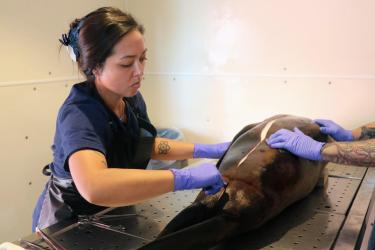Southern Resident killer whales have long pursued the biggest and most nourishing Chinook salmon from coastal Pacific waters. Chinook salmon fishing is also a mainstay of the West Coast economy, generating nearly $72 million in income last year.
Is there room for both?
The answer is yes, with safeguards. NOAA Fisheries prioritizes the needs of Southern Residents in setting salmon fishing seasons, as the Endangered Species Act requires. We also recognize the importance of salmon fisheries to port communities up and down the West Coast, as outlined by laws including the Magnuson Stevens Act.
We are working with states, tribes, and the Pacific Fishery Management Council (Council). We are examining in detail how West Coast fisheries affect prey for the Southern Residents. So far, the analysis has indicated that Council fisheries have been taking a small proportion of the available Chinook salmon each year.
Fishing Takes Small Fraction
The analysis comes in the form of a risk assessment evaluating the impacts of fishing on Southern Resident killer whales. It found that Southern Resident numbers have declined over the last two decades. This has occurred even as Chinook salmon abundance has varied and fishing harvest has decreased coastwide.
While salmon fisheries have usually been managed river-by-river, the risk assessment looked at them differently. It examined salmon abundance by geographic areas that at any given time include migrating fish from many stocks. This provides the most complete picture to date of the prey available to the whales in the areas where they forage.
For example, in 2016, the last year with data available, ocean salmon fisheries off the West Coast caught an estimated six percent of the 2.8 million adult Chinook salmon in offshore waters. Off the Washington Coast, the science indicates prey abundance is consistently more important to the Southern Residents when migrating in the Council management area. There, fishing removed just 2.5 percent of the 1.4 million available Chinook salmon.
This level of impact from coastal fishing off Washington on the Chinook salmon population overall is small compared to the natural year-to-year variations in salmon abundance. The continuing loss of vital nearshore habitat where young salmon feed and grow before they head to the ocean also limits fish numbers and recovery.
Limits in Canada and Alaska
We must also look beyond our own coast. Fishermen in Canada often catch more Puget Sound salmon than local fishermen do. Alaskan salmon fisheries catch very few fish from Puget Sound. However, they often catch many fish from the Columbia River before they turn south to areas where they would be available to the whales.
New provisions of the Pacific Salmon Treaty were renegotiated in 2019 between the United States and Canada. They have cut back catches of Chinook salmon throughout their migration from the Northwest to Alaska, which are expected to increase prey available to the whales. The new agreement also invests millions of dollars in additional Chinook hatchery production and habitat restoration to support salmon and Southern Resident recovery.
Just as importantly, fishing remains sustainable, which is the bottom line in setting salmon seasons for Council fisheries. You can feel confident that local salmon you find in stores and restaurants are sustainably caught. Better yet, you have a say in setting the seasons. Next, we will explain how.
Part two: Setting salmon seasons, and how you can help





